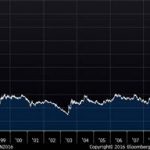Gold’s powerful surge in 2016 has been driven by utterly massive investment buying. This is a marked sea change from recent years, where investors relentlessly pulled capital out of gold. But with that dire sentiment reversing, they are rushing back in with a vengeance. Major investment capital inflows into gold are an exceedingly-bullish omen, as they are what transform a mere gold rally into a new bull market.
With gold enthusiasm growing, it’s easy to forget how radically different things looked just a few months ago. Back in mid-December the day after the Fed hiked rates for the first time in 9.5 years, gold dropped to a miserable 6.1-year secular low of $1051. The popular level of antipathy towards this asset class by investing professionals was mind-boggling. They universally believed it was doomed to keep spiraling lower.
But with gold so epically out of favor and loathed, it was a dream buy for the rare contrarians. On the final trading day of 2015 as gold still languished at $1060, I published an essay titled “Fueling Gold’s 2016 Upleg”. In it I explained what was going to “fuel a mighty new gold upleg in 2016”, drawing much ridicule. And that usual pattern of early-upleg gold buying has indeed played out exactly like I forecast.
New gold uplegs emerging out of major lows are always driven by three distinct stages of buying. First futures speculators cover short positions, then futures speculators add new long positions, and finally investors follow the futures speculators in. The third stage is the biggest and most critical, and it only happens if the futures speculators’ early buying boosts gold high enough for long enough to win over investors.
When gold plunges to a major new secular low, the futures speculators who’ve shorted it are the main initial buyers. Gold-futures trading requires very little cash up front relative to position sizes, granting extreme leverage which makes these bets incredibly risky. Futures speculators selling short effectively have to borrow gold before selling it. So they are legally obligated to soon buy gold back to cover and close their shorts.
After speculator gold-futures short covering ignites the initial rally out of major gold lows, sharp upside momentum attracts in more speculators on the long side. Unlike short covering which is compulsory, gold-futures long buying is totally voluntary. Speculators need to have a high level of conviction that gold will keep rallying instead of soon revisiting its recent lows to make these risky leveraged upside bets.
The leverage inherent in gold futures is astonishing. Back in 2015’s final week when gold averaged $1065, a single 100-troy-ounce gold-futures contract controlled $106,500 worth of gold. Yet the futures exchanges only required speculators to keep $3750 cash per contract in their accounts as maintenance margins. That works out to 28.4x leverage, so a mere 3.5% adverse move in gold could wipe out traders.
Today after gold’s mighty early-2016 rally, the situation isn’t much less extreme. The CME has raised its gold-futures maintenance margins to $4500 per contract, but at this week’s $1240 gold levels each one is worth $124,000. That works out to similar 27.6x maximum leverage today in gold futures, which is so far beyond the legal limit of 2.0x in the stock markets imposed by the Fed in 1974 that it boggles the mind.
Since trading anything at 20x+ leverage is so insanely unforgiving and dangerous, the actual numbers of speculators willing to shoulder such instant-bankruptcy risks are small. So any gold rally only fueled by gold-futures speculators covering shorts and then adding new longs will soon fizzle out. Though this elite group of traders can really bull the gold price around, the pools of capital they control are small and finite.
Thus futures speculators are incapable of doing the heavy lifting necessary to grow a gold rally into a major new upleg or bull market. Gold rallies in recent years have stalled out when futures speculators either chose to stop buying or ran out of capital firepower. In order to transform into something much bigger, investors have to follow futures speculators into gold. They must take the gold-buying baton from speculators!
Of course investors control vastly larger pools of capital than speculators, so they have the means to buy gold for years on end while speculators can only sustain a few months of heavy buying. But essential differences between investors and speculators go far beyond that. Unlike speculators, investors use little or no leverage and buy for long time horizons instead of just day-to-day momentum. So they are strong hands.
Gold’s surge this year is so darned powerful because investors have indeed usurped the gold-buying leadership from futures speculators for the first time in some years! Unfortunately this is not yet widely understood because the gold world is so vexingly opaque. Gold trades in an enormous global market that has evolved over millennia, with fantastic complexity in terms of trading venues and numbers of participants.
The best global gold demand data comes from the venerable World Gold Council. This elite marketing organization is funded by the world’s biggest and best gold miners, and has excellent global resources at its disposal to gather gold investment data. The problem is this big effort takes lots of time. The WGC can’t collect, analyze, and publish quarterly gold-investment numbers until about 6 weeks after quarters end.


















Leave A Comment